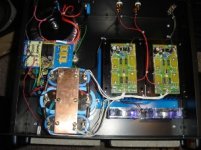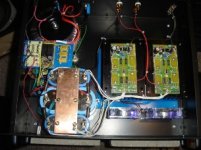No, Highly reccomend building a proper spkr protect ciruit with a spkr cutout relay.Similar to
http://sound.westhost.com/project33.htm.............;)
http://sound.westhost.com/project33.htm.............;)
sixtek said:(And the fuse produces audible distortions too...)
Care to explain that?
Also look up a uPC1237HA IC, it's an speaker protection, anti thump on-off, and more.
XEAGLEKEEPER said:Have you used it?
Not yet, but I do have 10 of them on my bench staring me down
I have a Clarion car amp schematic that uses one of them for the protection, but they don't use an output relay.
Skorpio said:Why does a fuse not protect sufficient?
Why do speaker woofers burn with DC?
The fuses are too slow, they take time to heat up and then snap the wire in it glass tube. As were a protection IC can do this 1000 (or more) times faster then a fuse can It also doesn't need to be replaced, it's not prone to nucense blows and can trip at 1V offset or less(as were a fuse requires many volts before it opens).
A speaker is a AC device, to put it basicly if you put in 1W of audio signal(AC) into a speaker, it will put out 1W of sound vibrations (this is extremely simplifed) but if it gets DC all it can do it pop in or out and the 1W of DC (for example) will turn into heat and not sound waves. If the DC is Large enough the speaker will be damaged before the fuse even knows whats happening.
XEAGLEKEEPER said:ESP P101 "They Rock"
Drool I love these things, mite have to get a few more boards from Rod Elliott.
Also a big NO NO for a 5A fuse...
... may be I am overcorrect, but no matter how far we simplify things.... If you put some AC power into the speaker.. then almost all of this power will be converted to heat. Acoustic output is ranging between 0.01% and 5%.
And the thermal behaviour of a speaker voice coil is in a similar way time lag as a medium speed fuse....
BUT:
1: Power ratings of speaker are complete rubbish.
They are specified in order to give high numbers.
Even so called true RMS ratings and trustseeking IEC standards describe measurements with ON/OFF duty cycles that are mostly OFF.
(OK, rubbish is a hard word. Of course these methods make some sense, because real music is quite dynamic and average power is 10...20 times less than the max levels.)
To make the thermal reality more visible:
May be your speaker has a voice coil 50mm diameter and is rated with something like 200W rms...
Now have a look to a 40W light bulb and compare the size (==> size can be used as a simplified indicator for the ability to dissipate heat) and think about the temperatures of the light bulb....
2: If you apply DC, then cone does only jump once to high excursion and stops moving there. At AC the swinging of the cone is acting as a very good effective ventilation system for the voice coil, which transfers the heat to the magnet and may be to the back ventilation. This allows several times higher AC power than DC power.
If you put this together you will come to the conclusion that a fuse has to be calculated for the allowed DC power. Means something between 1W and 10W for most woofers (If you calculate the fuse rating, you must use the DC resistance of the speaker!). Unfortunately this will not allow the full AC power anymore, quite some db wasted.
Furtheron such a fuse can only protect sufficiently if the speaker does not get a mechanic damage from the DC.
This is limiting the range of allowed amplifiers. In case of a high power amp driving small speakers a fuse protection cannot protect the speaker vs mechanical damage.
... may be I am overcorrect, but no matter how far we simplify things.... If you put some AC power into the speaker.. then almost all of this power will be converted to heat. Acoustic output is ranging between 0.01% and 5%.
And the thermal behaviour of a speaker voice coil is in a similar way time lag as a medium speed fuse....
BUT:
1: Power ratings of speaker are complete rubbish.
They are specified in order to give high numbers.
Even so called true RMS ratings and trustseeking IEC standards describe measurements with ON/OFF duty cycles that are mostly OFF.
(OK, rubbish is a hard word. Of course these methods make some sense, because real music is quite dynamic and average power is 10...20 times less than the max levels.)
To make the thermal reality more visible:
May be your speaker has a voice coil 50mm diameter and is rated with something like 200W rms...
Now have a look to a 40W light bulb and compare the size (==> size can be used as a simplified indicator for the ability to dissipate heat) and think about the temperatures of the light bulb....
2: If you apply DC, then cone does only jump once to high excursion and stops moving there. At AC the swinging of the cone is acting as a very good effective ventilation system for the voice coil, which transfers the heat to the magnet and may be to the back ventilation. This allows several times higher AC power than DC power.
If you put this together you will come to the conclusion that a fuse has to be calculated for the allowed DC power. Means something between 1W and 10W for most woofers (If you calculate the fuse rating, you must use the DC resistance of the speaker!). Unfortunately this will not allow the full AC power anymore, quite some db wasted.
Furtheron such a fuse can only protect sufficiently if the speaker does not get a mechanic damage from the DC.
This is limiting the range of allowed amplifiers. In case of a high power amp driving small speakers a fuse protection cannot protect the speaker vs mechanical damage.
- Status
- This old topic is closed. If you want to reopen this topic, contact a moderator using the "Report Post" button.
- Home
- Amplifiers
- Solid State
- Loudspeaker protection...

